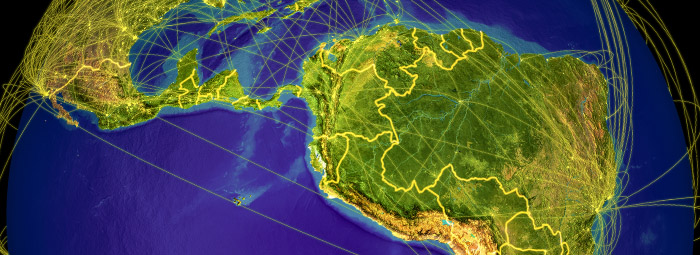The trends for the logistics industry during this decade are linked to the growth of commerce and economies and focus on implementing technologies such as artificial intelligence and the internet of things to understand the preferences of clients and avoid stock gaps.
Latin America is one of the regions with the highest rate of growth in e-commerce, thanks mostly to operations located in Brazil, Mexico and Argentina.
The expectations raised by e-commerce in Latin America have forced companies to automate their warehouses, optimize order fulfillment, improve their delivery speed, and provide a better customer experience. For Latin American companies to reach true profitability it is necessary for them to combine all these factors in the current, and overly demanding, market.
%20trad%20rev%20final%20924%20palabras.jpg?width=2500&name=Tendencias%20clave%20que%20est%C3%83%C2%A1n%20marcado%20el%20crecimiento%20de%20la%20industria%20log%C3%83-stica%20en%20Latam%20V2%20(3)%20trad%20rev%20final%20924%20palabras.jpg)
Logistics trends for 2020
These are some challenges and trends that will continue setting the pace for the logistics sector in Latin America during the next years:
From a strategic and operational point of view:
- Improving the return process in e-commerce: Returning products deeply impact profitability; therefore, increasingly more companies take advantage of services like reverse logistics, repairs, restoration, repackaging, resending, and reselling offered by logistics companies.
- Outsourcing the management of the supply chain: Hiring a logistics company allows companies to focus on their core business. This practice is becoming increasingly more common throughout Latin America because companies understand that running out of stock is a very expensive risk.
- Creating partnerships with other companies: Partnering with companies such as fuel sellers has helped big e-commerce companies react quickly and creatively to the demands of their clients.
- Implementing green logistics: Since clients have become increasingly aware of their carbon footprint, companies must implement environment-friendly strategies such as switching packaging materials or using sustainable transportation.
- Adopting an omnichannel strategy: This novel consumer paradigm has modified the logistics processes since, nowadays, clients relate to companies in various channels: they might buy at the company’s webpage, use social media to post comments, and return merchandise at the brick and mortar store.
- Improving professionalization: Currently, logistics professionals must be familiar with and manage new and developing technologies and systems.
From a technological viewpoint:
- Implementing warehouse automation: Fast deliveries force companies to place their warehouses near cities and to automate their warehousing using robots to stack and move merchandise.
- Using predictive analytics: Thanks to big data, we can anticipate the needs of warehouses and optimize the inventory to avoid shortages.
- Acquiring special technology: Looking to find more efficient routes, some companies have started to buy software capable of recruiting fleets of trucks, planes, and ships to move their products.
- Integrating the supply chains: Integrating companies with logistics service providers using big data to adapt and move products is one way to improve service levels.
- Digitalizing the supply chain: Offering a good product at a competitive price is no longer enough, we must now deliver goods to clients when they want them and how they want them; to achieve this, we must predict the future using technology and adapt to changes through digitalization.
- Creating immersive experiences: Thanks to augmented reality, this type of experiences helps train staff on how to prepare orders or manage inventories.
- Using blockchain in the future: This technology prevents the manipulation of the goods’ information throughout the supply chain.
Other trends for retailers relate to the mobility offered for electronic payments, bidimensional reading, and self-service systems. All this to offer quick attention, safety, and efficiency.
In short, the trends for logistics for this new decade must meet the demands of an interconnected world with clients buying 24/7 on their smartphones.
The logistics leader in 2020
The growth of e-commerce platforms represents an opportunity for gaining clients and for providing efficient service at a low cost. Those companies that understand this will be able to meet their short-, medium-, and long-term goals.
Latin America’s 3PL companies are undergoing a modernization and restructuring so they can meet the ever-changing demands of clients caused by e-commerce. The industry itself will change as much as technology changes. With the implementation of chatbots, real-time tracking, personalized deliveries, and robots, among others, clients will be better informed, and suppliers will be able to adapt better to their needs.
Any use of new technologies by specialized logistics companies require a successful transition geared up to an internal implementation. To achieve this, companies must rely on 3PLs that can show proof of having real experience in applying these changes and employing the newest tools. Such is the case for Solistica, which offers the most advanced technology to provide the best experience.







